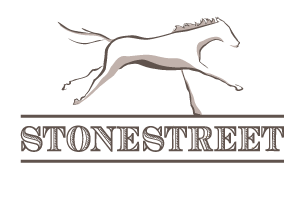Shortly after birth, a foal will make its first attempts to stand and, before long, succeeds. While starting off a little wobbly, that same foal will be running next to mom in a paddock in no time. Still very small and developing, the hooves are the foundation of a well-built horse and it is important to care for them.
The first six months are an important time for a foal’s hooves. At two weeks of age the foal will meet the farrier for the first time. The foal has been familiarized with human contact since birth and is used to having his hooves handled by a groom. A hoof pick, wire brush and rasp are the only tools necessary when addressing a foal’s hooves.
Our farrier examines each hoof and how the shape of the hoof is affecting the entire limb. During this first examination the foal is stood on a solid, level surface. While standing the farrier views the foal from the front and from the side. By drawing an imaginary line from the elbow down to the toe, one is able see how straight the legs are. The foal is also observed at the walk to assess how evenly each hoof touches the ground.
Proper alignment of the limbs is important for a consistently sound racehorse. If any abnormalities are detected, the farrier and Broodmare Farm Manager will decide if the problem stems from the hoof or misalignment of the joints in the limb.
Conformational issues of the foot include “Toeing In”, where the toe of the hoof points inwards, “Toeing Out”, where the toe of the hoof points outwards, and a “club foot”, where a flexural deformity of the coffin joint causes a raised heel, or upright angle to the hoof.
During the walk, the farrier and Broodmare Farm Manager are looking to see if the horse is placing each hoof on the ground evenly. When a horse walks, each hoof hits the ground at a different time, but at this slow speed, the entire hoof should hit the ground all at once. In some cases, a hoof may be hitting on the outside or inside wall first before the rest of the hoof makes contact due to a misalignment.
Farrier visits are especially effective in the first 6 months of a foal’s life. During this time, the hoof and bones are growing rapidly. Because a foal’s hoof is very small, picking out is quick and a rasp is used to file, or shape, the hoof. If no abnormalities are found, the hoof will be trimmed evenly and level. Trimming at an angle is a technique used to correct any conformational issues. For example, if a horse is “Toeing In”, the impact side of the hoof (the inside wall) would be trimmed lower than the outside wall making the hoof come in contact with the ground evenly, correcting the misalignment.
Until a foal is 90 days old, the farrier will continue to visit a foal every two weeks. As the foot grows and matures over the firsts year of life, farrier visits will reduce to once a month. By trimming frequently in these early stages, a farrier is able to correct or minimize misalignment issues from the beginning, giving every foal the opportunity to start out on the right foot.
